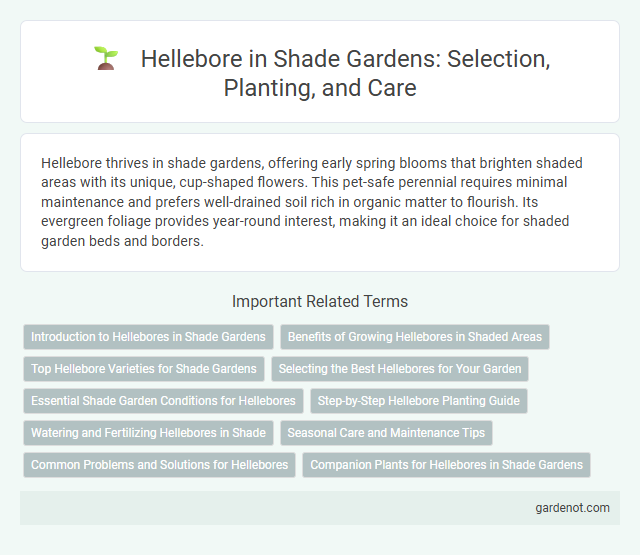Hellebore thrives in shade gardens, offering early spring blooms that brighten shaded areas with its unique, cup-shaped flowers. This pet-safe perennial requires minimal maintenance and prefers well-drained soil rich in organic matter to flourish. Its evergreen foliage provides year-round interest, making it an ideal choice for shaded garden beds and borders.
Introduction to Hellebores in Shade Gardens
Hellebores are perennial shade garden favorites known for their early-blooming flowers and evergreen foliage, thriving in low-light environments under trees or shrubs. Their tolerance to dry shade and adaptable soil preferences make them ideal for adding consistent color and texture to shaded garden areas. With bloom times ranging from late winter to early spring, hellebores provide valuable seasonal interest when few other plants are in flower.
Benefits of Growing Hellebores in Shaded Areas
Hellebores thrive in shaded areas, making them ideal for shade gardens where many plants struggle to bloom. Their early spring flowers provide essential color and interest during seasons when other shade plants remain dormant. These perennials also offer evergreen foliage, contributing to year-round garden structure and reducing soil erosion in shaded garden beds.
Top Hellebore Varieties for Shade Gardens
Top hellebore varieties for shade gardens include Helleborus orientalis, known for its early spring blooms and diverse color palette ranging from white to deep purple. Helleborus niger, or Christmas rose, thrives in shaded areas and provides striking white flowers during winter months. Helleborus foetidus offers unique greenish-yellow nodding blossoms ideal for adding texture and color to shaded garden beds.
Selecting the Best Hellebores for Your Garden
Selecting the best hellebores for your shade garden involves choosing varieties with strong disease resistance and vibrant bloom colors like Helleborus orientalis or Helleborus niger for winter interest. Look for hellebores with early blooming periods and robust foliage to ensure year-round garden appeal and minimal maintenance. Opt for cultivars such as 'Pink Frost' or 'Royal Heritage' that thrive in shaded, well-drained soil to maximize growth and ornamental value.
Essential Shade Garden Conditions for Hellebores
Hellebores thrive in well-drained, humus-rich soil with consistent moisture and partial to full shade, making them ideal for shaded garden areas. They prefer protection from harsh afternoon sun and benefit from a mulch layer to maintain soil moisture and temperature stability. These perennials tolerate cold winters and perform best in sheltered spots where air circulation is moderate but not stagnant.
Step-by-Step Hellebore Planting Guide
Choose a shaded location with well-draining, rich soil to plant hellebores, ensuring they receive protection from harsh afternoon sun. Dig a hole twice the width of the root ball and mix compost into the soil to enhance fertility and moisture retention. Position the hellebore crown just below the soil surface, backfill carefully, and water thoroughly to establish strong root growth.
Watering and Fertilizing Hellebores in Shade
Hellebores thrive in consistently moist, well-drained soil, requiring regular watering to prevent dryness, especially during dry spells in shaded gardens. Fertilize these shade-loving perennials in early spring with a balanced, slow-release fertilizer or organic compost to support robust growth and abundant blooms. Avoid overwatering and heavy feeding, which can lead to root rot and excessive foliage at the expense of flowers.
Seasonal Care and Maintenance Tips
Hellebores thrive in shaded areas with well-drained soil, benefiting from regular watering during dry spells to prevent stress. In late winter or early spring, remove old, damaged leaves to enhance airflow and reduce fungal disease risks. Applying a layer of organic mulch in fall helps retain moisture and protects roots from temperature fluctuations throughout the winter months.
Common Problems and Solutions for Hellebores
Hellebores commonly face issues such as black spot, leaf blight, and aphid infestations, which cause discoloration and damage to foliage. Ensuring proper air circulation and removing affected leaves promptly can reduce fungal diseases, while using insecticidal soap or neem oil effectively controls pests. Applying mulch helps maintain soil moisture and prevents root rot, promoting overall plant health in shade gardens.
Companion Plants for Hellebores in Shade Gardens
Hellebores thrive when paired with shade-tolerant companions like ferns, hostas, and astilbes, which complement their early blooms and provide contrasting foliage textures. These plants share similar moisture and soil requirements, creating a harmonious environment that enhances visual appeal and promotes healthy growth. Incorporating evergreen shrubs such as boxwood or heuchera can extend seasonal interest and maintain structural balance in shade gardens with hellebores.
Hellebore Infographic

 gardenot.com
gardenot.com